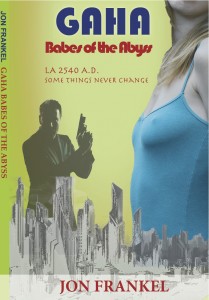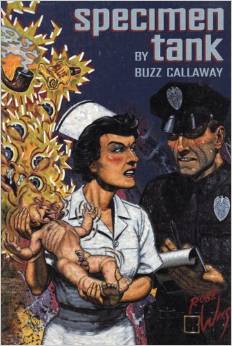bosse de nage, mr ha ha
“PA UBU.–Hornstrumpet! We shall not have succeeded in demolishing everything unless we demolish the ruins as well. But the only way I can see of doing that is to use them to put up a lot of fine, well-designed buildings.”
Bosse De Nage is the baboon who accompanies Dr. Faustroll on his adventures in Jarry’s Exploits and Opinions of Dr. Faustroll. In my early twenties I read and enjoyed his work. One of my favorite books is The Banquet Yearsby Roger Shattuck, which is a biography of Jarry, Satie, Apollinaire, Rousseau and Picasso, and an inspiring portrait of Bohemian Paris in the 1880s and 90s . (The Banquet Years is a marvelous companion to The bride and the bachelors : five masters of the avant-garde, by Calvin Tomkins, which does the same for Ives Tanguely, Merce Cummingham, John Cage, Robert Rauschenberg and Marcel Duchamp). But I didn’t give him much serious thought. He was the outrageous, Ur-clown of the avant-garde, the great proto-punk of modernity. Ubu Roi I took to be the kind of one-off brilliant performance that obliterates everything else in an artist’s life. And the ‘pataphysical business seemed to be precious; a dry, intellectual joke. I came to think of Jarry as the inebriated, broke, ether-breathing, ambsinthe-swilling psychopath who ended his days fishing in the Seine, the man who becomes his own creation.
I was surprised then when in the course of writing Endangered SpeciesI had to reread some Jarry. There came a point in ES when I needed to stage some sort of anarchist avant-garde event. Since it all began with Ubu Roi, what better place to start? And the characters in the book who perform Ubu Roiwere very loosely based on people I was close to at one time. One of these people had been passionate about Jarry and ‘Pataphysics. We used to discuss them at some length. So I thought I should actually read more than the Ubu plays. His output was slim in terms of number of pages, so I read just about everything he wrote, as well as Alfred Jarry, an imagination in revolt by Jill Fell, an art historian. Fell reconnects Jarry to symbolist art and analyzes his iconography and the block prints he made to decorate his early books. What emerged from all this was not a buffoon with a brilliant, subversive mind but a literary genius. And more surprising than that was the resonance with a totally unrelated passion of mine, Finnegans Wake. This stunned me. Jarry is ten or so years older than Joyce, and died before Joyce was in Paris. But there were uncanny similarities in their work, and they shared many of the same obsessions. Naturally Joyce would have met people who knew Jarry, and Jarry’s influence was immense. They both liked to drink, were apostate Catholics with Jesuit educations, and neither ever got over their adolescent intellectual antagonisms, nor their bodily obsessions, especially with shit and transgressive sex. They were both genuinely attracted to and in love with popular entertainment and both were immersed in the occult. But the connections go deeper and I believe they lie in Symbolism.
Jarry was a serious symbolist early on, and that is the artistic milieu from which Joyce, the realist, emerges. Among the many symbols and theories that Jarry played with is letter symbolism. The letter H is extremely important to him as it is a homophone with Hache or hatchet, and it incorporates both a vertical sign and a horizontal sign. Like Joyce Jarry was obsessed with the coincidentia oppositorum. The vertical sign is masculine, penetrative, violent. The horizontal is negative, female and receptive. H is the initial consonant of HCE, Joyce’s Father who falls off a ladder and dies and whose wake is celebrated in the book. Another letter both men often invoked is Tau, or The Greek Cross. Jarry engraved the Tau in his early works and incorporated it as the preferred symbol of the crucifixion. Tau and T appear frequently in the pages of Finnegans Wake as a symbol of death. Ana is another connection. In one of Jarry’s novel an important scene takes place in a shrine to Saint Ana, a natural spring, and she is invoked as The Mother. Anna Livia Plurabelle, ALP, is Joyce’s figure of the mother; she is the unconscious, the ocean of the universe, all rivers and she is the flow of language through life. She is A, alpha, Aleph, the First, the source of the ALL. Combinations of the letters HCE and ALP recur throughout Finnegans Wake, and they turn up in Jarry as well(such as PAL, which means Stake in French, juxtaposed to HOLE). And then there is the spiral, the narrative structure of Finnegans Wake (derived from all spirals, Vico’s historical spirals, Dante’s, and the ancient labyrinth symbolism of graves and journeys to the underworld). The spiral appears on Pa Ubu’s belly, the gidouille, and in the quoted passage.
The passage I quote below is about the death of Bosse de Nage. Bosse de Nage only says two words: Ha Ha. He is often consulted by his absurd and abstruse philosophical companions, and always gives the same answer.
To anyone who has spent time wandering the Barzakh of Finnegans Wake, it will be perfectly clear what the connections are. To those who haven’t, it is still a diverting example of outrageous prose. And it might seem like a lot of pseudo-scientific falderoll but I think Jarry’s purpose was serious. He had read (and cites in Faustroll) Clerk Maxwell. Jarry was interested in field theory and electromagnetism. In these theories he found a science that described a universe of interconnected energies, a universe of identity, whose vulgar aspect is the pun. Both Joyce and Jarry are savage, satirical clowns with a serious purpose, but it would be a mistake to think that all this clowning is there to disguise something. I believe it is there to express something, that the truth of our universe is that in both its creative an destructive aspects it is essentially absurd and comic, that the truth and the outrage are not far apart. Here then is the death of bosse de nage, bottom-face:
“Ha ha!” and these were the last two words he uttered.
29
CONCERNING SOME FURTHER AND MORE
EVIDENT MEANINGS OF THE WORDS “HA HA”
… And I’ll declare
He’s mooning up some landscap’d alley where A ha ha lurks ahead. All unaware He won’t, until he’s tumbled, know it’s there.
We may properly treat here of the customary and succinct speech of Bosse-de-Nage, so that it may be made clear that it is with reasonable intention and not from mockery that we have always reported it in its full extent, together with the most probable cause of its premature interruption.
“HA HA,” he said concisely; but we are in no way concerned with the accidental fact that he usually added nothing more.
In the first instance, it is more judicious to use the orthography AA, for the aspiration h was never written in the ancient languages of the world. It proclaimed in Bosse-de-Nage effort, servile and obligatory labor, and the consciousness of his inferiority.
A juxtaposed to A, with the former obviously equal to the latter, is the formula of the principle of identity: a thing is itself. It is at the same time the most excellent refutation of this very proposition, since the two A’s differ in space, when we write them, if not indeed in time, just as two twins are never born together – even when issuing from the obscene hiatus of the mouth of Bosse de Nage.
The first A was perhaps congruent to the second, and we will therefore willingly write thus: A = A.
Pronounced quickly enough, until the letters become confounded, it is the idea of unity.
Pronounced slowly, it is the idea of duality, of echo, of distance, of symmetry, of greatness and duration, of the two principles of good and evil.
But this duality proves also that the perception of Bosse de Nage was notoriously discontinuous, not to say discontinuous and analytical, unsuited to all syntheses and to all adequations.
One may confidently assume that he could only perceive space in two dimensions, and was refractory to the idea of progress, implying, as it does, a spiral figure.
It would be a complicated problem to study, in addition, whether the first A was the efficient cause of the second. Let us content ourselves with noting that since Bosse de Nage usually uttered only AA and nothing more (AAA would be the medical formula Amalgamate), he had evidently no notion of the Holy Trinity, nor of all things triple, nor of the undefined, which commences at three, nor of the indeterminate, nor of the Universe, which may be defined as the Several.
Nor of anyone else. And, in fact, the day he was married, he indeed felt that his wife was chaste with him, but he could not tell whether she was a virgin.
And in his public life he never understood the use, on the boulevards, of those iron kiosks whose popular name derives from the fact that they are divided into three triangular prisms and that one can use only one-third at a time; and he remained, until his death, branded thus by Captain Kidd:
BOSSE-DE-NAGE Papio cynocephalus,
befouling and ravaging everything indiscriminately.
We have purposely omitted to say, these meanings being very well-known, that ha ha is a ditched gap in a wall at the end of a garden path, an armed pit or military well into which chrome steel bridges may collapse, and that AA may still be read on the medals struck at Metz. If Faustroll’s skiff had had a bowsprit, ha ha would have designated a special sail placed beneath the jibs.




